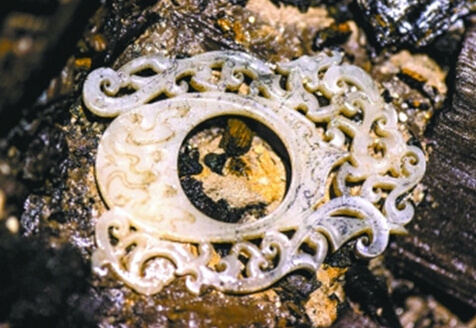Further excavations at Haihunhou Cemetery, Jiangxi
From:CCTV English NetWriter:Date:2015-11-20
Tributes to Confucius, and 15 tons of coins, are among the latest finds at the ancient Haihunhou Cemetery. Dating from the Han Dynasty, the site lies near Nanchang, capital of Jiangxi Province.The treasures keep on coming at Haihunhou, with a set of lacquer screens that seem to bear a portrait of Confucius, along with a text about his life.
Archeologists believe the main tomb is that of Liu He, grandson of Emperor Wu, the most famed ruler of China's Han Dynasty, which ran from from 206 BC to 24 AD.

Among more than 10,000 items, the team have found gold, bronze, and iron items, along with cooking utensils, wine vessels, lamps, jade pieces, wood tablets, bamboo slips, 15 tons of bronze coins, and even chariots.
Liu was given the title "Haihunhou" - or "Marquis of Haihun" - after he was deposed as emperor after only 27 days.
"The Han Dynasty upheld Confucianism as its sole doctrine. The practice was initiated during the rule of Emperor Wu. Liu He was a grandson of Emperor Wu, so a Confucius portrait and his biography accord with the then social background. The screens can tell us the hierarchical status of the tomb owner. We can see at the excavation site Chinese characters on the screens, which are about the life of Confucius. And the portrait of the sage is also likely to be Confucius," said Yang Jun, associate researcher of Jiangxi Provincial Institute of Archaeology.
The cemetery is located one kilometer away from Nanchang in southeastern China's Jiangxi Province. It has eight tombs in all and a chariot burial site with walls that stretch for almost 900 meters.
After a five-year study, archaeologists consider these the best-preserved royal tombs of the West Han Dynasty ever discovered in China.

The treasures keep on coming at Haihunhou, with a set of lacquer screens that seem to bear a portrait of Confucius, along with a text about his life.
Among more than 10,000 items, the team have found gold, bronze, and iron items, along with cooking utensils, wine vessels, lamps, jade pieces, wood tablets, bamboo slips, 15 tons of bronze coins, and even chariots.
Characters on some objects record their date of production and functions - invaluable information for historians.
"We can study many systems and social conditions of the Western Han Dynasty according to the characters on the unearthed practical materials, which means we can possibly use the materials as proof on many occasions without the support of documents," Yang said.
Jiangxi's cultural department is continuing to excavate the site and study its finds.

